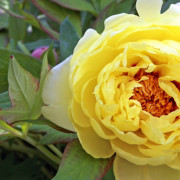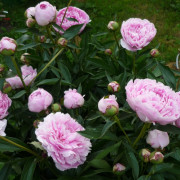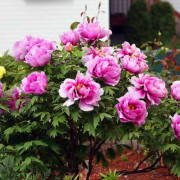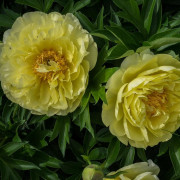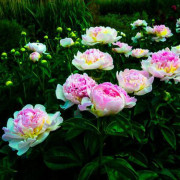Peony Cora Louise (Paeonia Itoh Cora Louise)
Content:
For a long time, flower lovers have been growing herbaceous and tree-like peonies. But Ito-peonies or Ito-hybrids (itoh hybrid) are really something new. They combined all the best qualities of both herbaceous and tree-like varieties. The Cora Louise variety belongs to this amazing group and takes pride of place in it. The peony has many advantages, but it needs especially careful care.
Peony Itoh Cora Louise (Paeonia Itoh Cora Louise)
Ito's peony hybrids appeared in Japan thanks to the efforts of the Japanese scientist - botanist Toichi Ito. The first representatives of the group had yellow inflorescences, but in the course of further experiments it was possible to breed varieties with a huge spectrum of shades.
As a result of crossing herbaceous and tree-like peonies, it was possible to obtain almost universal plants, which adopted all the best from their progenitors. They are characterized by the dying off of the herbaceous part for the winter and the formation of buds, as well as herbaceous varieties. From tree-like peonies, they adopted the appearance - the shape of a bush, leaves and flowers.
Description of the variety Cora Louise
Peony Cora Louise is a powerful spreading plant 40-50 cm high. The leaves are dark green, carved, and the shoots are herbaceous, but very strong. Due to the combination of the qualities of the two species, the shoots are able to withstand the weight of the flowers and not bend, which allows them to be grown without additional support.
The originality of the color of the inflorescences is a distinctive feature of the Cora Louise peony. Large semi-double inflorescences have white-pink petals and a dark purple center, on which dark yellow stamens are densely located. The aroma is not expressed brightly - it is subtle and slightly sweet.
Advantages and disadvantages
Considering that the peony ito-hybrid Cora Louise took the best qualities from the ancestors, it has many advantages:
- unusual color of flowers;
- ease of care;
- climate resilience;
- undemanding to the frequency of feeding;
- the splendor and compactness of the bush.
Disadvantages are very difficult to find. The only feature that can cause confusion is pruning. Shoots before the onset of cold weather should not be cut at the root, but shortened to a certain length.
Use in landscape design
The Cora Louise variety has already taken an honorable place in the list of favorite cultures of landscape designers. It is used in multi-tiered flower beds, ornamental shrubs and conifers are planted in the foreground, and group plantings look especially impressive.
Planting and growing
Peony Cora Louise is propagated by root cuttings or parts of an adult bush. Planting is best done in autumn, mid or late September.
The landing site should be sunny, but light partial shade is acceptable. With a close occurrence of groundwater, a drainage layer will be required during planting.
Training
The stage preceding planting is the preparation of the seedling and soil. It is necessary not only for good survival, but also for the full development and growth of the plant in the future.
The procedure consists of two stages:
- The soil on the site is dug up a year before planting with the addition of rotted manure. For 3-4 weeks, a complex mineral fertilizer is applied.
- The roots are washed, dried and examined.Too long and dry roots are removed, and the cuts are sprinkled with ash or activated carbon.
When all the preparatory work is completed, you can proceed to the planting itself.
Landing in the ground
Landing pits are prepared in advance. A month before the procedure, a site is marked out, taking into account that the size of the depression should be 40x50 cm, and the distance between the plants should be 80-90 cm.
Planting process step by step:
- A drainage layer is poured at the bottom of the pit.
- The cone is filled with nutrient soil.
- Place the root system.
- Gently watered along the inner perimeter of the pit.
- Close up of planting.
- Water it again abundantly, compact the soil and mulch.
Seed planting
The Cora Luis variety belongs to hybrids, and seed propagation is not applicable to it. This is not only a long and laborious process, but also meaningless. Seed-grown specimens do not inherit the qualities of the mother plant.
Outdoor care
Unpretentiousness is one of the advantages that the Cora Luis peony favorably distinguishes. It is very easy to look after him.
Care features:
- The flower needs moderate watering as the soil dries up, but during flowering it is necessary to moisten the soil often and abundantly.
- If the site was filled with fertilizers before planting, no fertilizing is needed. Otherwise, they are applied 3 times using a complex mineral fertilizer.
- It is better to mulch the plot and periodically renew the mulch layer. If this event is ignored, it is necessary to regularly loosen the soil.
- The resistance of the flower to diseases allows not to apply preventive spraying, but to resort to them only in case of infection.
Peony Blossom Cora Louise
Depending on the climate, buds begin to appear in late May or early June. During this active period, it is necessary to pay a little more attention to the peony - to feed it and water it more often. Gradually, the intensity of care is reduced to transfer the flower to the stage of winter dormancy.
How to care for a peony after flowering:
- After wilting of all inflorescences, they are removed. If you need to transplant or propagate a peony, this is the right time. It is best to carry out the procedure in mid-September.
- A feature of hybrid Ito-peonies is non-standard pruning. The stems are not completely cut, but only the herbaceous part of the shoots is cut. The lignified parts must be left, since it is on them that buds will form next year.
- After pruning, the plant is covered. In warmer regions, a layer of compost or dry manure will suffice. In the northern regions, it is better to additionally cover the plantings with spruce branches.
Diseases and pests, methods of dealing with them
Peony Cora Louise is very rarely affected by diseases, and with proper care it does not suffer from pests. If, nevertheless, the infection has occurred, the treatment must be carried out immediately. In severe cases, chemical means of control are used, and if the problem is at an early stage, with folk remedies.
Cora Louise is a striking representative of a completely new group of Ito-pions. In addition to the stunning appearance of flowers, shoots and leaves, it has such a remarkable quality as unpretentiousness. The benefits of culture regularly make flower growers want to grow this novelty in the world of peonies.














